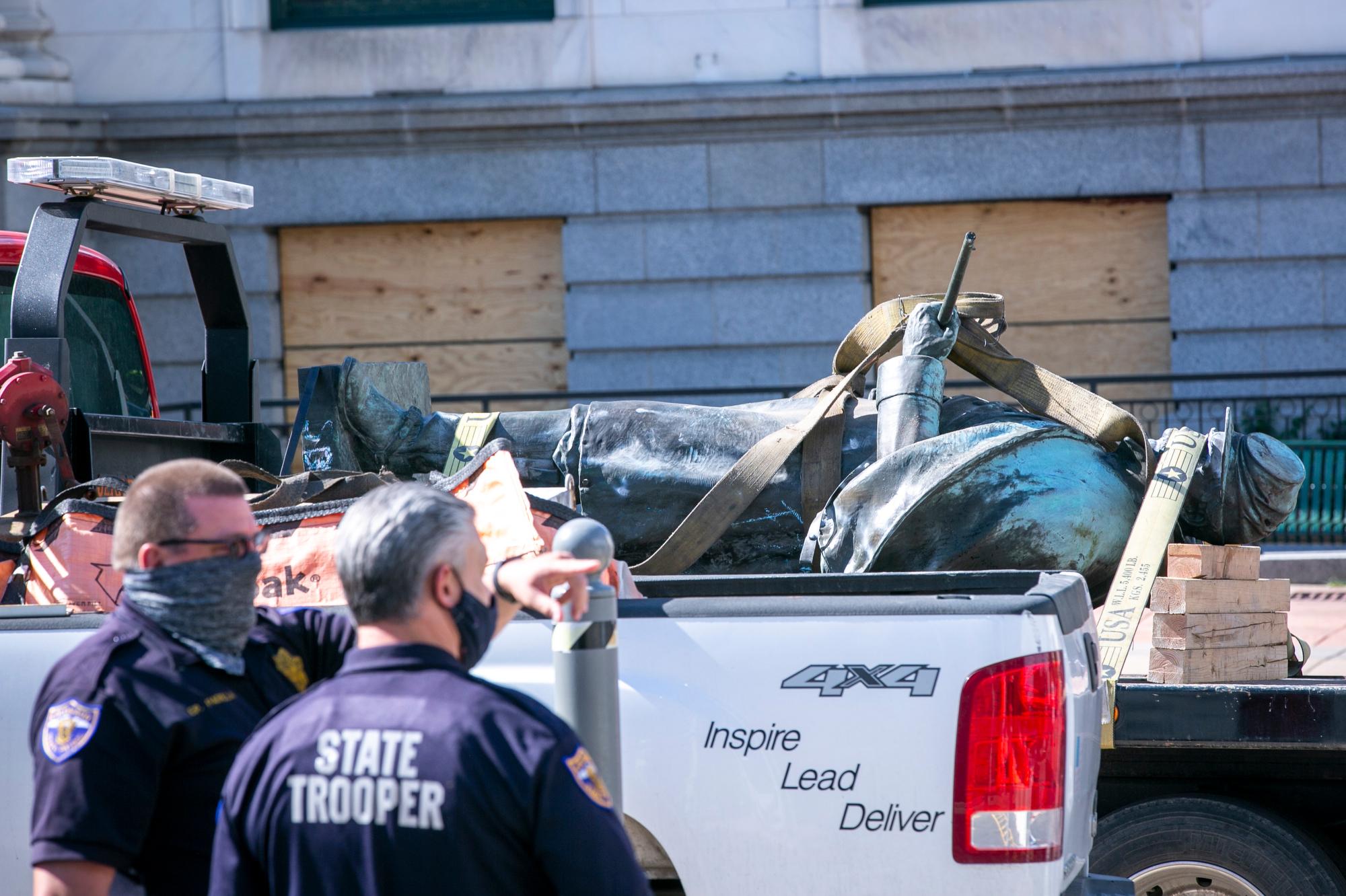
For more than a hundred years, the statue of a Colorado cavalryman stood high on a plinth outside the state Capitol, with a rifle in his hands and his eyes on Mount Evans in the distance. But the monument also marked a darker side of the state’s military history: the massacre of more than 230 Native Americans at Sand Creek.
Now the statue is off its perch, apparently permanently, and its future is uncertain.
In November, the committee that manages the Capitol grounds voted to replace the monument to frontier soldiers with a remembrance of the victims of an atrocity they committed. That shift marks a culmination of years of effort by tribal groups. But it also raises another question — what to do with the toppled soldier statue?
“Wherever the statue goes, I think it needs to be protected, so that it can be viewed,” said Flint Whitlock, a veteran and military historian who wrote a book about Colorado’s role in the Civil War.
Whitlock thinks the monument still has a role to play in educating people. “Most Coloradans, I think, don't even realize that Colorado was involved in the Civil War, let alone fought in a major battle here in the far West.”
On Guard memorial erected in 1909
A volunteer regiment from Colorado took on Confederate soldiers at the Battle of Glorieta Pass, near the New Mexico border, in 1862. The Union victory stymied Confederate plans to seize the state’s rich goldfields and push on toward the West Coast, denying the breakaway states’ needed capital.
However, two years later, some of those same troops carried out the infamous attack at Sand Creek on a village of more than 700 Cheyenne and Arapahoe, who believed themselves under the protection of the U.S. government.
When the memorial, officially named On Guard, was erected in 1909, it recast the massacre as a battle, and included it on a list of conflicts the Colorado troops engaged in. The state moved to address that whitewashing in 2002, adding a plaque that explained the true history of Sand Creek, but anger over the monument and calls to remove it persisted over the years.
“For this one specifically, especially, yes. It had to come down,” said Jeffrey Means, a history professor at the University of Wyoming and a member of the Oglala Sioux nation. While Means thinks the history of Colorado’s volunteer cavalry should be remembered, the heroic side can’t be separated from the brutal.
“There's absolutely room for the narrative to contain multi-facets of what the United States Army and the Cavalry were during this period,” but Sand Creek, he said, “is a wound that's still open and until it's healed, it will never be part of our distant past that we're going to get over and forget.”
From a controversial past to an uncertain future
In voting to replace the Civil War memorial with a monument to Sand Creek, the Capitol Building Advisory Committee didn’t address what to do with the displaced statue.
For the next year, it has a temporary home at History Colorado. From its lofty height, the statue is now closer to earth. It stands on a low plywood base, in a quiet corner of the museum’s atrium, with a spiral staircase wrapping around behind it.
“There's actually a really great view if you go all the way to the top and look down. It's a view that we don't get of monuments very often,” said Jason Hanson, the museum’s chief creative officer and director of interpretation and research. “That was part of the project here in presenting this as an artifact for people to see in a new light and maybe think about in a different way than they had before.”
The statue is now surrounded by other people’s stories too; the museum solicited commentary from descendents of the victims of the Sand Creek massacre, as well as historians and representatives from veterans groups. And, before the pandemic closed the museum for a second time this year, guests were invited to leave their thoughts on Post-It notes stuck to the wall.
One read: “Toppling or defacing a monument or statue because it offends you means that you don't know history or [how] that person or event had changed the lives of people. The purpose of a monument is to educate and remind us of our past and to see how far we have come as a people.”
“I think that's a really interesting perspective that it's meant to be outdated,” Hanson said after reading the note.
Statue could be relocated
One option for the statue, if leaders at the Capitol really are ready to divest themselves of it, might be to offer it as a permanent gift to History Colorado. And there may be other organizations interested in giving it a home too. Whitlock, the Colorado military historian, sits on the board of the Broomfield Veterans Museum. They’ve talked briefly about offering to bring the statue there.
Wherever the Civil War statue does end up, its stop at History Colorado has led Whitlock to view it in a different light too.
“Looking at it in that context and having comments and remarks by other people about their feelings about the monument, I think really helps me to perhaps understand more of what the monument means and meant. And to realize that there are always two sides to every story,” he said.








